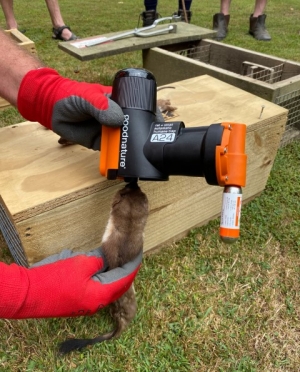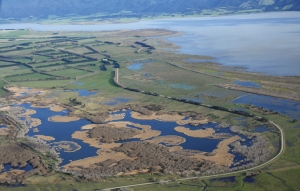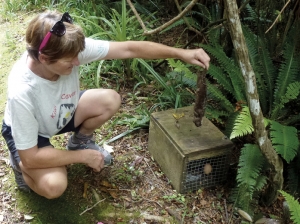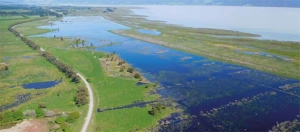Displaying items by tag: Predators
Leading predators up the garden path
Mammalian predators rely primarily on smell as their main cue, enabling them to detect food from a distance. Smell is usually a reliable strategy for food location.
As part of long-running research into the behaviour of introduced mammalian predators in New Zealand and Australia, researchers from Manaaki Whenua – Landcare Research and the University of Sydney asked whether it might be possible to manipulate predator behaviour by using misinformation. Could we use unrewarded prey odour cues to fool predators, and make them ignore real prey cues? If we could make predators less efficient at hunting, might we also make them miss real prey?
Over two nesting seasons, the researchers tested the response of cats, ferrets and hedgehogs to false odour cues at nesting sites for three shorebird species – the banded dotterel, wrybill and South Island pied oystercatcher. These native bird species nest on the ground on braided rivers in Canterbury and are highly vulnerable to predators. The researchers made odorous pastes from bird carcasses and feathers – and tested whether repeated exposure to these odours would affect the predators’ behaviours.
They set out the pastes at 300 to 400 points across nesting sites before the birds arrived to nest, and also during the nesting season. Predators’ behaviour was then compared to that at testing sites without paste.
Camera traps were used to monitor predators’ interest in the paste, and to monitor the survival of nests with and without odour paste.
In the second nesting season, the paste/ no-paste sites were swapped to increase the reliability of the results. All three types of predator were attracted by the paste odours, but ferrets and cats, in particular, quickly lost interest when there were no prey associated with the scent cues.
Thus, when the birds arrived to nest, the predators had already altered their behaviour by ignoring bird odour, including that of the real birds.
The effects on nest survival were striking for all three bird species: compared with non-treated sites, odour treatments resulted in a 1.7-fold increase in chick production over 25 to 35 days and doubled or tripled the odds of successful hatching.
For banded dotterel, the researchers estimate that this intervention could result in a 127 per cent increase in the population size in 25 years of annual odour treatment.
The method is best suited to small areas of vulnerable biodiversity where lethal control methods are difficult to implement.
Lead researcher Dr Grant Norbury of Manaaki Whenua – Landcare Research worked with colleagues at the University of Sydney, Dr Catherine Price and Prof Peter Banks, who developed the idea.
Dr Norbury says that this field experiment provides clear evidence of altering predators’ perceptions of prey availability on a landscape scale, and “could significantly reduce predation rates and produce population-level benefits for vulnerable prey species at ecologically relevant scales, without any direct interference with animals”.
Photos: Grant Norbury
Predator control goes on hold
Predator control goes on hold
The Department of Conservation had to suspend all non-essential services,
including predator control programmes,during Covid-19 Level 4, which began
on March 5.
But the timing of the lockdown in many ways couldn't have been better, Brent Beaven, Predator Free 2050 manager for DOC, said.
Most birds weren't breeding, and most of the pests weren't breeding either, so he didn't expect to see a massive rise in pest numbers.
Predator control activities on public land were able to resume from May 13 when New Zealand moved to Level 2.
There was more good news the next day, with Predator Free 2050 receiving an
extra $76 million ($19 million a year) in the 2020 Budget, enabling it to co-fund new predator free projects around the country.
Thousands of hunters, however, had to wait until May 23, when the delayed duck hunting season began. It was extended until July 12.
In many places, wildlife appeared to enjoy the break from the madding crowds.
In Dunedin, the Otago Museum's Tropical Forest, home to hundreds of tropical butteries, staff reported some unusual cheeping sounds.
They discovered the forest’s zebra finches, apparently for the first time,
were raising chicks, partly because of the break from the usual stream of human visitors.
In Australia, scientists took advantage of the lack of maritime activity to learn the language of the Burrunan dolphins, a rare species which live in the Gippsland Lakes in Victoria. The scientists set up acoustic sound monitoring and, for the first time, were able to listen to what the dolphins had to say.
Further afield, there were reports of wildlife occupying abandoned spaces. These included a herd of wild goats taking over a town in north Wales, pink flamingos flourished in Albania, and wild boars roamed the streets of Haifa, Israel.
Let’s hit them with some tech
DU Director Dan Steele looks at another tool to help in the fight against predators.
The biggest problem with conservation in New Zealand is complacency and believing that someone else is looking after mother nature on your behalf.
So many people leave things to the Department of Conservation and believe that that’s enough.
It’s not, it’s going to take a huge combined effort from many New Zealanders and particularly landowners to slow the decline in our biodiversity caused by these introduced pests.
But it is not easy to start a conservation project, it is usually an extra job for already busy landowners and who pays, how is it going to be maintained and what should be done?
We ran a really good trapping demonstration for our local sustainable farming group last week, the Taumarunui Sustainable Land Management Group.
Mustelid expert Professor Carolyn (Kim) King, of Waikato University, gave a great overview of New Zealand pests, how we got to this point and whether pest-free New Zealand has any hope of success. The jury is still out on this.
But she believes future technology may well make it possible.
We’re trying to demonstrate that it’s quick and easy to set a few traps around the farm; knowing what to do is often the biggest obstacle with farmers. Then of course there is the capital cost to set up traps and the ongoing maintenance. Goodnature, a Wellington pest company founded 13 years ago, is certainly making the setup and the maintenance easy with their well thought-out technology.
The new Chirp feature on their traps provides bluetooth information from the trap direct to your smartphone.
You link your phone to the trap and it logs the GPS coordinates, and when you check the trap, it tells you how many strikes the trap has had and when.
Then once you’re back into cellphone reception or internet connection, the information is automatically uploaded to the cloud onto the Goodnature world map.
Your traps and kills can be viewed by anyone looking at the map – they show up orange.
Cunningly though, when people are viewing your traplines, they can only see to within 150 metres of where you have your traps placed, so people can’t turn up and steal or sabotage your traps. The owner of the traps can however have their GPS coordinates down to a metre or two.
We are finding the A24 Goodnature traps a good way for people to sponsor some traps, to be involved and stay in touch with how the conservation work
is performing.
It’s so important to be holding our ground against predators; this week at Blue Duck Station, we have had a kaka sighting and a report of a bittern booming.
The Goodnature A24 rat and stoat trap automatically kills 24 rats or stoats (and mice) one after the other, before you need to replace the CO2 gas canister. When the pest tries to reach the lure inside the trap, they brush past a trigger which fires a piston, killing them instantly. The piston retracts and resets ready for the next pest. The trap comes with a pump that refreshes the lure automatically for six months. Three different trap kits are available: a trap-only kit, a trap with a counter or a trap with Chirp.
Watch out predators – Steve’s on the job
In late November Steve Playle did a trap run at Boggy Pond and Wairio. The count was 1 ferret, 1 rat and 10 hedgehogs.
“The ferret was a big bugger and was caught along the stop bank between Mathews and Boggy. This took the total predator count to 23 ferrets, 1 stoat, 2 weasels, 4 cats, 5 rats and 14 hedgehogs.” said Steve.
Rampant growth of grass and weeds along with warm weather meant extra time cleaning around trap sites. Steve also put out another seven DoC250 traps on the Wairio Restoration Block along with two more timms traps along a pine belt where cats have been seen.
Stock tends to interfere with the traps in the Wairio Restoration Block. “We have to live with that unfortunately,” said Steve.
Mice also play havoc with baits with most traps stripped of meat if they have not had a kill in them. Steve said he knows it’s mostly mice because the DoC traps have mouse droppings in them. He has seen mice in the timms traps too. “With only one ferret for this check it could mean their numbers and getting down or maybe they are feasting on mice or even frogs as the place is alive with them at the moment,” said Steve.
Steve has seen and heard bitterns and another was heard at Mathews pond.
Trapping is ongoing.
Predator Free New Zealand
Maybe - but not just yet
- aims for a sustainable yield
- never takes more individuals than the population can replace
- can be like the constant harvest by rabbit trappers, deer cullers, and predators
- a population can’t be affected if the yield is not declining.
- protection of a valued resource can be ineffective unless broader ecological/ sociological context is understood
- the interaction of resource/habitat/ people defines the outcome
- solutions require strategic organisation, stakeholders agreement and effective methods
- the biology and strategic organisation determine effective policy (which DU does very well).
- Forgetting that nature is on the predators’ side and ignoring the effects of natural selection
- Counting numbers removed, not numbers remaining,
- Lack of coordinated, agreed strategy
- Lack of flexibility in response to experience
- Insufficient stakeholder support.
- Inefficient tools
- Failing to deploy combination of methods
- Having no effect on fertility, immigration.
- Operator confidence, meticulous preparation, sufficient funding
- Never repeating mistakes, never giving up, so accumulating improvements, combining/switching strategies when necessary
- Landscape scale coordination
- Strong community support.
New technology
- Adds to natural mortality
- Prevents immigration
- Targets fertility
- Confirms benefit to native species.
Boggy Pond April rounds
Ferret lured by sardine juice
The ferret must have liked the smell of the juice from the ‘Sardines in Springwater’. Note the colour of the ferret, mostly white.
Another hedgehog trap used, DO 200 (pic right). Blackbirds use the top of the trap to crack the snail shells on. It is awash of snail ‘juice’, for the want of a better word, and the trap is surrounded by empty snail shells, sometimes this activity sets the trap off.
Protecting Whio
Keen predator hunter protecting Whio
The Ruahine Whio Protection Trust (RWPT) is a registered charity formed in late 2014 and functions though the efforts of a small group enthusiastically lead by chairwoman Janet Wilson. Its purpose is to raise funds to help protect and raise the number of Whio in the Ruahines and surrounds.
Janet has tramped for years in the Ruahines as a member of the Palmerston North Tramping and Mountaineering Club (PNTMC), and whio are often spotted on the river. Although being a protector of whio was not Janet’s original ambition, she took the opportunity to become a protector of the whio living and trying to survive in the area. Janet took over the running of the Oroua Valley Blue Duck Protection project from the NZDA (Manawatu Branch) in 2011. This expanded in to the Pohangina River in 2012.
“Life hasn’t been the same since,” said Janet. Trapping began in the Ruahines in 2007. Several groups now look after approx 1800 predator traps, predominantly DOC 200’s. These range from the Aorangi–Awarua Trust’s lands in the North to the Pohangina River in the South. In 2015 a Ruahine Whio Management Plan was developed by these groups with support from DOC, and along with the RWPT, they now make up what is known as the Ruahine Whio Protectors Collective.
Janet still coordinates the Oroua and Pohangina projects. Between July 2015 and June 2016, 110 stoats and weasels were caught, as well as 450 rats. She has a good team of willing volunteers but is always keen to hear from experienced trampers and hunters who might like to help out the whio. For many a tramp in the bush is no longer just a Sunday outing. It has become an ongoing war against the stoats, weasels, rats, and any other likely whio enemy.
Whio are the most endangered bird in the Manawatu and Janet is keen to raise the profile of our $10 duck locally. Janet said the Oroua and Pohangina rivers have the most southern population in the North Island. There are no known whio in the in the Tararua and Rimutaka ranges.
The need for continual predator control
I run a yearly total as at November 30 each year as part of the excellent initiative of the ‘Swamp Comp’.
For the year ending November 2015 from 6 DoC 200 traps placed around the margins of my wetlands, the list was 11 Weasels, 1 Stoat, 2 Ferrets, 33 Hedgehogs and 7 Rats.
So for the 2016 year where 2 more traps were added in February, with the total of 4 Weasels, and Stoats, 1 Ferret, 12 Hedgehogs and 16 Rats it seemed that we were making a great inroad.
It may seem now that the inroad thought was rather premature, with just under 5 months of the current year run, the total sits at 20 Weasels, 3 Stoats, 7 Hedgehogs and 9 Rats.
The other point is that I have one trap [See photo, note there is an egg, I also bait with the juice from Sardines in spring-water] that is generally located in a central position, with the other traps generally outside of it.
That trap known as Cabbage Tree, has accounted for 15 of the Weasels, 2 Stoats, and 4 Rats, the last one as of April 25.
Possibly the high number may be attributed to the very wet Summer-Autumn where the wetland core which is generally only damp under the Harakeke, Coprosma and Toe Toe associations is this year very wet, so perhaps there is a concentration moving around the dryer margins, however that is only a possible theory as equally the food abundance could be another contributing factor.
Ian Jensen.
Hard Work at Boggy Pond
- 62 cats,
- 140 ferrets,
- 8 stoats,
- 53 weasels,
- 652 hedgehogs and
- 295 rats.






